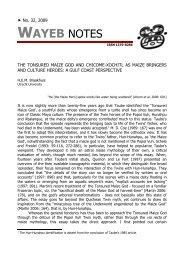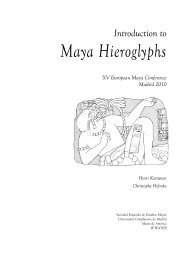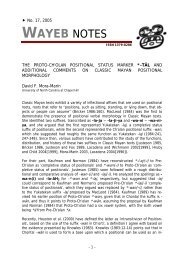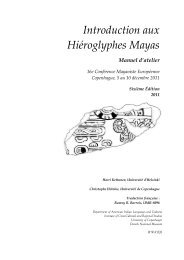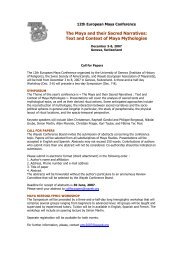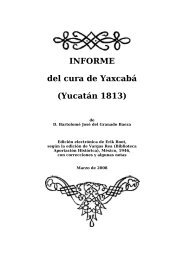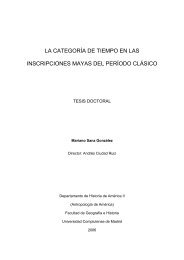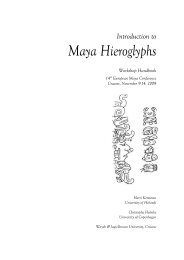Introduction to Maya Hieroglyphs - Wayeb
Introduction to Maya Hieroglyphs - Wayeb
Introduction to Maya Hieroglyphs - Wayeb
You also want an ePaper? Increase the reach of your titles
YUMPU automatically turns print PDFs into web optimized ePapers that Google loves.
Kettunen & Helmke 2011<br />
<strong>Introduction</strong><br />
NOTE ON THE ORTHOGRAPHY<br />
The conventions of orthography have plagued <strong>Maya</strong> studies since the very beginning of the discipline. <strong>Maya</strong><br />
words have been and still are written in sundry fashion. One illuminating example is the numerously used word<br />
for ‘lord’ or ‘king’ which appears at least in five different forms in the <strong>Maya</strong> literature: ahau, ahaw, ajau, ajaw and<br />
’ajaw. Since the ratification of the new official alphabets for the Guatemalan <strong>Maya</strong> languages (Acuerdo Gubernativo<br />
numero 1046-87 [23rd of November 1987]) and its modification (Acuerdo Gubernativo numero 129-88 [2nd of March<br />
1988]), and its subsequent publication (Lenguas <strong>Maya</strong>s de Guatemala: Documen<strong>to</strong> de referencia para la pronunciación de<br />
los nuevos alfabe<strong>to</strong>s oficiales), most but not all <strong>Maya</strong> scholars around the world have started <strong>to</strong> use the new alphabet<br />
in their publications, with one addition, the distinction between h/j for Classic <strong>Maya</strong>.<br />
When it comes <strong>to</strong> the application of this new alphabet, one can notice various ways of dealing with the issue. The<br />
conventions of the orthography usually <strong>to</strong>uch four “domains” of groups of words:<br />
(1) Words in different <strong>Maya</strong> languages;<br />
(2) <strong>Maya</strong> words that are considered <strong>to</strong> be somewhat constant in the terminology of the <strong>Maya</strong> studies (such<br />
as day and month names [derived from colonial Yukatek]);<br />
(3) Place and proper names<br />
(4) Names of languages and ethnic groups<br />
On the other end of the “scale” are scholars, who use new alphabets for the words in <strong>Maya</strong> languages but retain<br />
the cus<strong>to</strong>m of using old (colonial) alphabets for the cases #2-4; in the middle of the scale are scholars with various<br />
solutions: some are applying the new alphabet for the Guatemalan <strong>Maya</strong> languages only (case #1), and old<br />
alphabets for the others; both of these might use either old or new orthography in the case #2. The <strong>Maya</strong> name for<br />
a so-called ‘day’ may be particularly revealing in this regard: e.g. Cauac/Kawak (see the section on Day Names,<br />
below).<br />
On the other end of the “scale” are scholars, who employ the new alphabets not only in the cases #1-2, but also in<br />
the cases #3-4 thus using Yukatan instead of Yucatan, Waxaktun instead of Uaxactun, and K’iche’ instead of<br />
Quiche or Quiché. Also, most scholars who have started employing the new orthography in all of the cases stated<br />
above, still maintain the convention of using traditional orthography for languages and ethnic groups outside the<br />
<strong>Maya</strong> realm, thus using words such as Q’eqchi’, Kaqchikel, and Wastek in the same text with Mixe, Zoque, and<br />
Nahuatl instead of using either one of the following sets:<br />
(a) Q’eqchi’, Kaqchikel, Wastek, Mihe, Soke, and Nawatl<br />
(b) Kekchi, Cakchiquel, Huastec, Mixe, Zoque, and Nahuatl<br />
Our position in this medley is that of finding a closely argued, consistent, and coherent standpoint. We have<br />
chosen <strong>to</strong> follow the sequent logic: when it comes <strong>to</strong> the <strong>Maya</strong> words, whether in the form of the above stated<br />
cases #1 or #2, we have chosen <strong>to</strong> follow the “new alphabet”. In the case of the place names we have chosen not <strong>to</strong><br />
follow the usage of the “new alphabet” since most place names are well established in the geographical<br />
vocabulary, including maps and road signs, and, furthermore, reflect a world-wide cus<strong>to</strong>m of natural<br />
“frozenness” of place names (on the same grounds the cities of Leicester and Gloucester in England retain their<br />
old orthographies, and their spellings are not revised <strong>to</strong> *Lester and *Gloster, respectively). Thus we are inclined<br />
<strong>to</strong> hold back <strong>to</strong> the traditional orthography in the case of such place names as Yucatan (not *Yukatan), Edzna (not<br />
*Etz’na or *Ets’na), Coba (not *Koba), and Uaxactun (instead of *Waxaktun or *Waxaktuun). Also, the accents<br />
represented on <strong>Maya</strong> words are redundant since all words of <strong>Maya</strong> origin are pronounced with the stress placed<br />
on their last syllable. Thus, the use of Spanish-derived accents is eliminated: thus e.g. Tonina instead of *Toniná 4 .<br />
The only exception is the usage of accents that represent <strong>to</strong>nes in languages such as Yukatek.<br />
However, in the case of the names of the <strong>Maya</strong> languages and “nations” we have chosen <strong>to</strong> follow the “new”<br />
orthography on the ground of practicality and rationality: practicality in the sense that the new forms of the<br />
languages and nations have been accepted (with some exceptions) by most scholars whether they live in Central<br />
4<br />
On the same grounds, for example, all words in Finnish (including place names) are not marked with accents due <strong>to</strong> the fact that in Finnish the<br />
stress is always on the first syllable; thus: Helsinki, not *Hélsinki (asterisks are used here <strong>to</strong> indicate incorrect spellings).<br />
7/154



